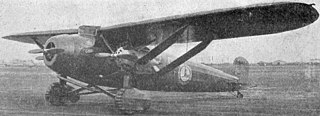Design
The two-seat B-4 trainer was a mid-wing monoplane with wings of rectangular plan out to blunted tips. Structurally, the largely wooden wings were based on pairs of box spars and spruce and plywood ribs, with duralumin sheet stiffening the leading edges. The rest of the wing was fabric covered. They were wire-braced from above and below with streamlined wires from pylons within the fuselage to the spars. Its Frise ailerons were inset. [1]

A monoplane is a fixed-wing aircraft with a single main wing plane, in contrast to a biplane or other multiplane, each of which has multiple planes.

In a fixed-wing aircraft, the spar is often the main structural member of the wing, running spanwise at right angles to the fuselage. The spar carries flight loads and the weight of the wings while on the ground. Other structural and forming members such as ribs may be attached to the spar or spars, with stressed skin construction also sharing the loads where it is used. There may be more than one spar in a wing or none at all. However, where a single spar carries the majority of the forces on it, it is known as the main spar.

A spruce is a tree of the genus Picea, a genus of about 35 species of coniferous evergreen trees in the family Pinaceae, found in the northern temperate and boreal (taiga) regions of the Earth. Spruces are large trees, from about 20–60 m tall when mature, and have whorled branches and conical form. They can be distinguished from other members of the pine family by their needles (leaves), which are four-sided and attached singly to small persistent peg-like structures on the branches, and by their cones, which hang downwards after they are pollinated. The needles are shed when 4–10 years old, leaving the branches rough with the retained pegs. In other similar genera, the branches are fairly smooth.
The B-4's fuselage was based on a chrome-molybdenum steel frame. It had a 95 hp (71 kW) American Cirrus III four-cylinder, upright inline engine in the nose with an aluminium firewall and tanks in the wing roots. The two tandem cockpits, fitted with dual controls, were over the wing. The view from the forward cockpit, placed around quarter-chord, was good and the instructor's view from the rear cockpit was improved with windows in the underside wing roots. [1]

The ADC Cirrus and Cirrus-Hermes are British aero engines of the mid-1920s. Sometimes known as the Blackburn Cirrus, examples remain airworthy today.

The straight or inline engine is an internal-combustion engine with all cylinders aligned in one row and having no offset. Usually found in four, six and eight cylinder configurations, they have been used in automobiles, locomotives and aircraft, although the term in-line has a broader meaning when applied to aircraft engines, see Inline engine (aviation).

In automotive engineering, the firewall is the part of the automobile body that separates the engine compartment from the passenger compartment. It is most commonly a separate component of the body or, in monocoque construction, a separate steel pressing, but may be continuous with the floorpan, or its edges may form part of the door pillars. The name originates from steam-powered vehicles, where the firewall separated the driver from the fire heating the boiler.
The B-4's empennage was conventional, framed like the wings and fabric covered. The tailplane was mounted at mid-fuselage height; its angle of incidence could be varied in-flight for trimming. It carried split, unbalanced elevators. There was a small fin with a curved-topped, straight-edged balanced rudder which extended down to the keel between the elevators. [1]

The empennage, also known as the tail or tail assembly, is a structure at the rear of an aircraft that provides stability during flight, in a way similar to the feathers on an arrow. The term derives from the French language word empenner which means "to feather an arrow". Most aircraft feature an empennage incorporating vertical and horizontal stabilising surfaces which stabilise the flight dynamics of yaw and pitch, as well as housing control surfaces.

A tailplane, also known as a horizontal stabiliser, is a small lifting surface located on the tail (empennage) behind the main lifting surfaces of a fixed-wing aircraft as well as other non-fixed-wing aircraft such as helicopters and gyroplanes. Not all fixed-wing aircraft have tailplanes. Canards, tailless and flying wing aircraft have no separate tailplane, while in V-tail aircraft the vertical stabilizer, rudder, and the tail-plane and elevator are combined to form two diagonal surfaces in a V layout.

On fixed-wing aircraft, the angle of incidence is the angle between the chord line of the wing where the wing is mounted to the fuselage, and a reference axis along the fuselage. The angle of incidence is fixed in the design of the aircraft, and with rare exceptions, cannot be varied in flight.
It had conventional, spilt axle, fixed landing gear with a 6 ft (1.8 m) track. The axles and drag struts were hinged from the same pylon used by the lower wing bracing wires. Struts joined the wheels, enclosed in fairings, to shock absorbers within the wing root aircraft fairings. At the rear the B-4 had a tripod tailskid with a vertical rubber shock absorbing extension of the rudder post. [1]

Landing gear is the undercarriage of an aircraft or spacecraft and may be used for either takeoff or landing. For aircraft it is generally both. It was also formerly called alighting gear by some manufacturers, such as the Glenn L. Martin Company.

A strut is a structural component commonly found in engineering, aeronautics, architecture and anatomy. Struts generally work by resisting longitudinal compression, but they may also serve in tension.

A shock absorber is a mechanical or hydraulic device designed to absorb and damp shock impulses. It does this by converting the kinetic energy of the shock into another form of energy which is then dissipated. Most shock absorbers are a form of dashpot.
















